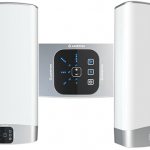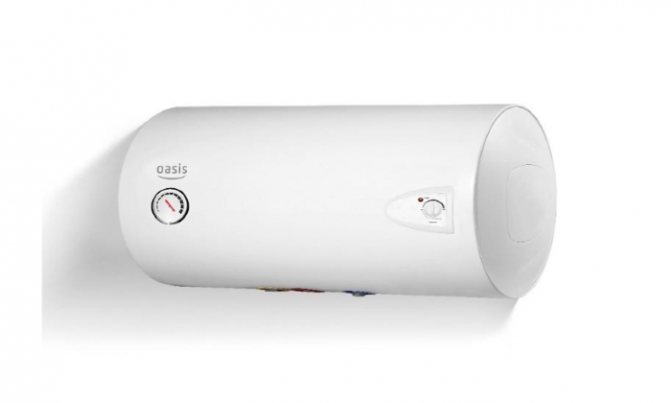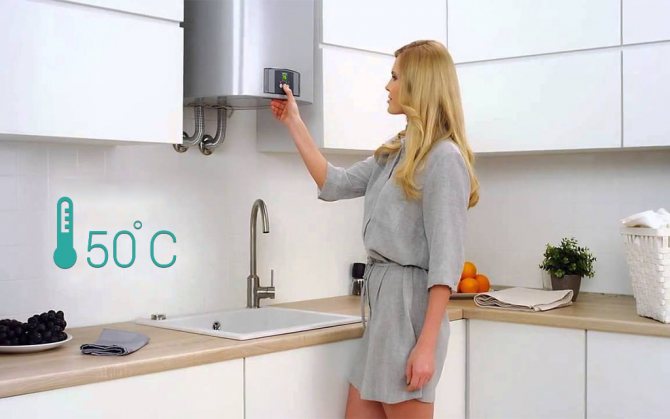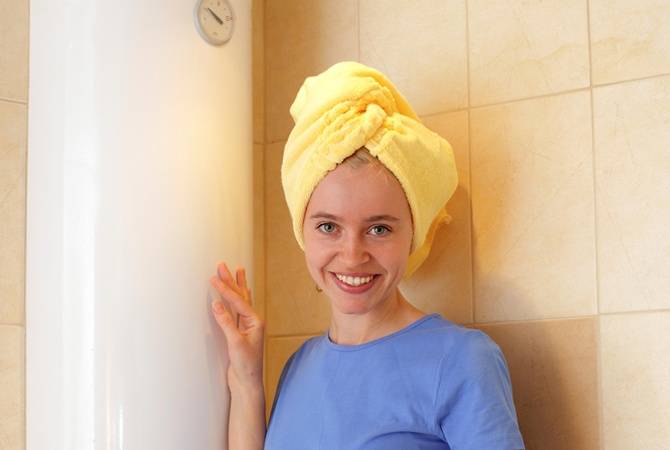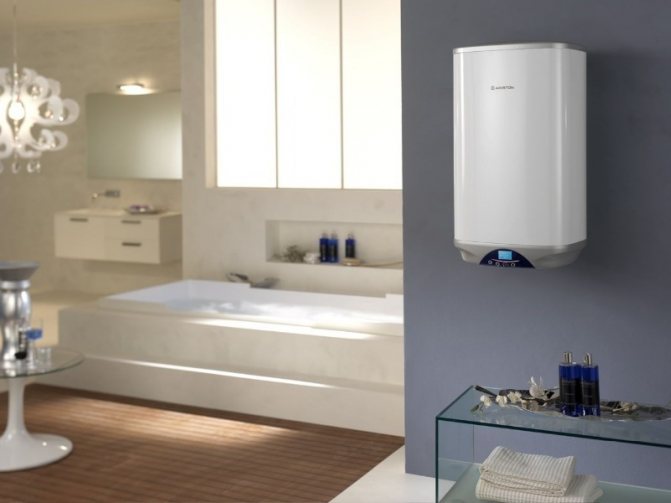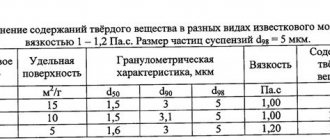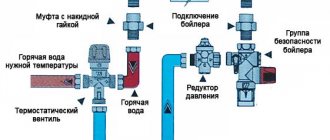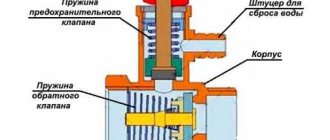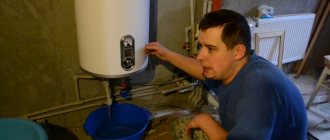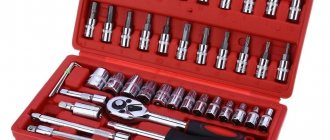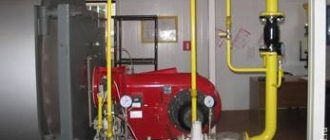The device and the principle of operation of technology
To rationally reduce energy costs, it is worth understanding the design of the water heater. It is designed as a stainless steel or steel tank with a layer of thermal insulation. Magnesium anodes are built into the steel tank to prevent corrosion and electrochemical reactions. A tubular heater with a thermostat is built into the tank. In the lower part of the tank there are pipes for supplying and releasing water. A thermostat and a thermometer are displayed on the front or bottom panel.
The device works as follows:
- Cold water is poured into the container through a hose with safety and return valves.
- The heating element turns on automatically and heats the water.
- When the contents of the tank reach the desired temperature, the heater is turned off using a thermostat.
- In models without tapping, the heating level is maintained in automatic mode - the heating element turns on and off after a certain time.
- By opening the hot water supply tap on the mixer, water is taken from the upper part through a special tube.
Features of boilers Ariston

Boiler Ariston
Italian technology is appreciated for its functionality, ergonomic design and affordable prices. The Ariston company produces electric and gas storage water heaters targeted at a wide range of people. The brand produces whole series of reliable equipment adapted to Russian operating conditions.
There are two types of heaters - gas and electric. The first is an improved column that works on a flow-through principle: heats water instantly with the help of gas. Such models fade into the background due to the high risk of fire.
Ariston gas boilers are presented by the manufacturer in one line with 6 models. They are intended for industrial applications. These are reliable floor-standing devices that provide heating of a large volume of water. The rest of the series are represented by electrical equipment. Ariston water heaters are divided into flow and storage, depending on the mechanism of action.
Instantaneous water heaters
These are compact devices with small tanks. The heating element in such a device is located in the pipe. When water passes through the electrical element, heating occurs: that is, there is no mixing of water.
Storage water heaters
The familiar name for this type is boiler. Externally, it is a steel tank with thermal insulation, into which water enters and is heated using a tubular electric heater. When the user turns the mixer knob, hot water from the tank mixes with cold water and flows through the tap. As the liquid in the container cools down, the device automatically turns on heating. The capacity of the tanks of Ariston boilers ranges from 10 to 200 liters.
Determination of the efficiency of a new water heater
How to start economically and correctly using a new boiler? Experts focus on determining its energy efficiency when purchasing.
General rules
Before purchasing equipment, the user needs:
- compare the energy efficiency of expensive and budget models in the store to establish the payback of the technique;
- to clarify that the energy efficiency class includes efficiency, losses per hour during heating and maintaining temperature, circulation. Information is indicated in the manufacturer's leaflet;
- take into account the capacity of the container, the speed of the heating element, the type of installation to clarify the total costs.
Interesting to know! On European models of boilers, energy efficiency has been indicated since 2013, on American models - since 2009.
Calculation of costs for annual operation
For calculations, you will need information about the energy efficiency class, type and cost of the coolant. Further calculations are performed according to the formula:
- for gas models, the number of days per year is multiplied by energy efficiency and the cost of a cubic meter of gas;
- for electric boilers, the number of days per year is multiplied by the energy efficiency and the cost of kWh.
Interesting to know! The DOE test for water heaters takes into account temperatures cold (15 degrees) and hot (60 degrees) and determines the performance of the device for a family of 3 people as 240 liters per day.
Heating element power as a saving factor
The greater the power of the heating element, the faster the water will heat up. Keep in mind that in houses with a single-phase wiring scheme, from 7 to 10 kW of power are allocated. A productive water heater will lead to an increase in the load on the network, huge energy costs and knocking out circuit breakers.
How to use the boiler economically?
It is necessary to save with the included water heater during its operation, and not choose the most budgetary model. Users give many tips on how to really save the electricity consumed on a domestic boiler. Below is the TOP of the most effective ones.
Installation and connection for economical operation
There are some simple tricks:
- selection of a suitable place for installation. The long length of the pipe from the bathtub to the sink results in heat dissipation. In this case, more kilowatts are spent;
- activity setting. You can select the periods of activity and restart of the heating element. It won't save you a lot, but it's a good start;
- preventive cleaning of the heater. After descaling, the heating element will generate a sufficient amount of heat with minimal energy consumption;
- one temperature level. The maximum setting provides quick heating, but increases energy consumption. By selecting a heating program, you can reduce the amount of energy consumed.
Important! In older models of boilers in heating mode, efficiency decreases and they consume more energy.
Reducing hot water consumption
Is it only about energy? You will not understand how to economically use a domestic boiler if you do not calculate the water consumption. To raise the temperature of 1 liter of water, 0.001 kW / h of heater power is needed. But even this is easy to save on.
Scheduled activation
It is worth starting the boiler only when hot water is really required. It is better to wait for the device to heat up than to pay huge bills. The switching schedule depends on the volume of the tank:
- water heaters with a capacity of up to 50 liters can be turned off before leaving the house and turned on upon returning. The device spends 1-1.5 hours on heating, then it simply keeps the water hot;
- boilers for 80-100 liters take longer to heat up, consume a large amount of energy. It is enough to set the temperature to a minimum and turn on the standby mode.
Advice! Buy and set a timer - it will turn on heating 2 times a day by the selected time.
Preheating
How can you save on a running boiler in winter? At a temperature of water in communications of the central type of 6-10 degrees, more energy is required for heating. To reduce costs, you need to fill a container of 50-100 liters with warm water and put it in the boiler room. It will heat up in 8-10 hours.
Important! The method is suitable only for residents of private houses and involves the use of alternative heat sources.
How to save money during boiler operation
Optimizing the functioning of the water heater will allow you to save a pretty penny on each heated liter of water:
- some consumers prefer to keep the boiler in “On” mode all the time;
- others - turn it on only when needed.
However, the second option will deprive you of the convenience of the storage heater, namely: "turn on the tap and get hot water." It takes a while to heat it up from scratch. Manufacturers and experts recommend an improved version number 1: let the device be always on, but it works at 60-70% power.
Most modern boilers have a mechanical or electronic water temperature control system. It is necessary to set it at the level of 55-60 ° С. The manufacturer, as a rule, indicates the exact recommendations in this regard in the product passport. On the scale of the regulator, sometimes the economy mode is denoted by the symbol E.
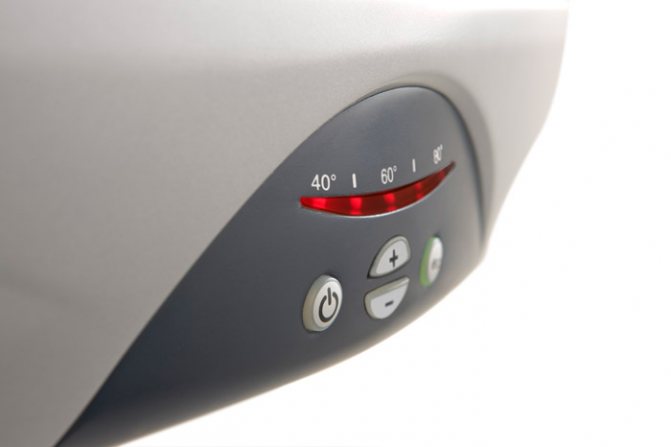

The temperature of the water in the boiler is regulated
The savings in this case are explained by the Fourier law of thermal conductivity, according to which the boiler will spend less energy if it heats the water not from scratch, but from a certain, "warm" temperature. Your water heater will periodically turn on and heat slightly cooled water. However, this way he will spend less kilowatts per unit of time than he would have used when bringing cold water to the same degree. This advice is appropriate and works if you use warm water more than once a day.
Attention! Reducing the temperature difference between the water in the tank and the required level of its heating also protects the heating element of the device from scale.
In advanced models of boilers, there is a programming function: water heating by a certain time. If you tailor the program to your family's schedule, then you can also get a decent benefit. Other measures to avoid unnecessary energy consumption when using the boiler:
- check the mixer and taps for leaks;
- at least once every two weeks, warm up the tank to the maximum and keep the temperature for about 2 hours to prevent the growth of bacteria;
- install a filter on the incoming water supply to protect heating and auxiliary elements from aggressive substances.
Attention! Determine the presence and number of filters based on the characteristics of the water in your water supply system. In some places they are not required at all. Most often, you need simple mesh or even additional filters (hard water or with impurities).
Energy efficient operation of water heaters
To eliminate overpayments for utilities, you need to figure out how to use a household boiler correctly and efficiently to efficiently save water and electricity. There are several ways.
Wastewater heat recovery
80 to 90% of the hot water energy is discharged into the sewer drain. The installation of the system allows using the heat of the waste liquid to heat the cold one. It is advisable to use 2 types of equipment in apartments and houses:
- with a buffer tank. Justified when using a washing machine or dishwasher. The effluent passes through a spiral tube in the reservoir, and their heat heats the water, which is pushed upwards. The water returns to the boiler in a preheated state;
- without buffer tank. A copper heat exchanger in the form of a spiral is wound on the sewer section. Preheated water is also returned through it.
Important! Depending on the intensity of use, the payback period for such equipment is 2.5-7 years.
Heat traps
When the heater pipes are connected to the top, the water rises and heats the pipes always. Convection loops conduct heat into the air where it is wasted. Installation of anti-convection ducts at the points where the pipeline is connected to the heater will increase the energy efficiency of the boiler.
Heat traps can be made by tying vertical pipes horizontally. To prevent the release of heat, plastic inserts are made at the joints of the pipes and heaters.
Lowering the water temperature in the water heater
There is a program selector on the outside panel.By setting the E (economical) mode, you will get water heating up to 55-60 degrees. The savings consist in increasing the resource of the heating element without consuming energy.
On the LCD panel, Eco mode can be programmed at a desired time. For boilers with mechanical control, just turn the knob.
Savings in the operation of the boiler provides a reduction in utility bills. There are many ways to improve the energy efficiency of your appliance. When choosing a specific option, be guided by the type of water heater and its displacement.
Almost every owner of this device knows how to use the boiler correctly, but the question is how to save energy on the boiler, without breaking the laws, know only a few. In this article, we will tell you how to save on hot water supply, and you will be able to rank yourself among those units of people.
Extending the life of the boiler
In order to avoid sudden temperature changes (especially for cheap water heaters), it is inappropriate to set too much heat, which over time can cause cracking of the tank walls. Change the magnesium anode periodically (about once a year).
Choosing a quality heating tank
In order for the water heater to work for a long time, when buying, they pay attention to the quality of the model. A good boiler must meet the following requirements:
- Have enough power. In this case, it is important to calculate that it matches the quality of the wiring in the house. New wiring can withstand a load of 6 kW, and the old one - no more than 2.5 kW. They take into account the fact that more powerful models consume more electricity.
- Boilers differ in "stuffing". Cheap ones have glass-ceramic and enamel coating, more expensive ones are made of titanium and stainless steel. But there is one caveat: some users of boilers with a stainless steel tank note the appearance of an unpleasant aftertaste of water.
- The thickness of the tank insulation is at least 35 millimeters. The water heats up faster (less energy consumption) and the temperature remains longer.
- There is overheating protection.
- The degree of protection against moisture and dust (IP) is at least 23, and for a bathroom, where the humidity is high, at least 44.
- There is a frost prevention mode if the device is purchased for a summer residence.
It is important to choose a boiler by volume, depending on the number of people living together. So, for one person, a 30 liter tank is enough.
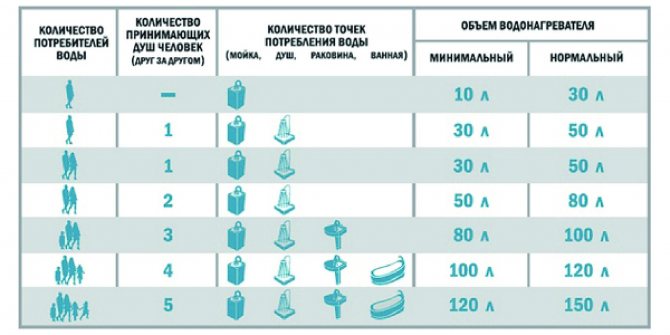

You also need to take into account that the devices are available with wet and dry heating elements. The second is safer, since it excludes the possibility of electric shock.
Timely troubleshooting
You can prevent boiler breakdowns if you regularly carry out preventive inspections. Any malfunctions should be eliminated immediately, without waiting for the water heater to fail. The condition of the magnesium anode and safety valve should be checked annually.
Regular cleaning
Once a year it is necessary to descale the boiler. You can invite the master of the service center or clean it yourself. The water heater is disconnected from the network, water is poured out, the electronic "filling" and the heating element are removed. The heating element is cleaned and installed in place.
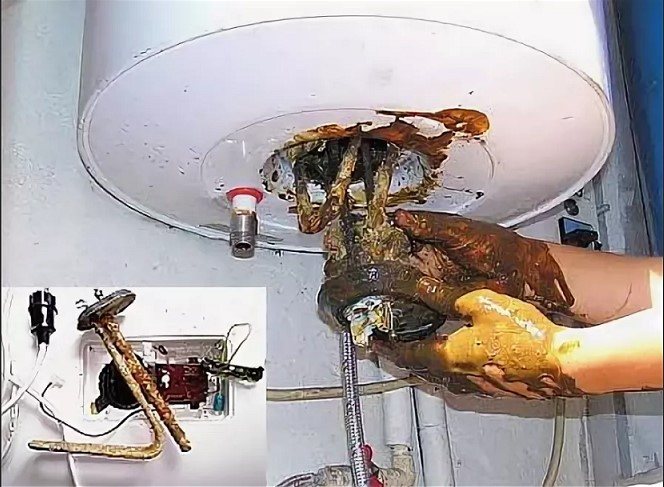

The correct choice of the heater model, reasonable operation, regular cleaning will allow you to use the device for a long time. And if you follow the above recommendations, you can achieve 15-20 percent savings in electricity consumption.
Methods to Reduce Electricity Costs
To do this, you must adhere to the following tips:
- Find the best place for installing the boiler. After all, if too large a pipeline runs to the sink or bath, then the heat will naturally dissipate, forcing you to spend more kilowatts.
- Choose the correct operating mode for the device. To save money, you need to correctly configure the active and inactive periods of the device, namely the heating element, you can save a small amount on kilowatts.
- Carry out preventive cleaning of the heating element (heating element). By cleaning it from scale, you can increase the efficiency of the element, namely, get the same amount of heat, with less energy consumption.
By sticking to all these points, you can save a small amount of electricity, which will positively affect your budget.
See also -
How to clean a boiler yourself
We select the right place to install the boiler
When you open a tap with hot water, you will most often have slightly warm water pouring out from there. Why is that? You may ask, since the liquid inside the heat exchanger is hot and there is no doubt about that, however, the boiling water must reach the tap, having previously displaced the cold liquid in the pipe. In a pipe 1 meter long and half an inch in diameter, due to the loss of temperature, it will be necessary to cover the loss of 200 milliliters of fluid.
After the valve on the tap was closed, you lose the same volume of warm liquid, because the "unused" liquid will remain in the pipes until the next opening of the valve. We can conclude that every time you use a tap, your boiler consumes at least 400 milliliters for each running meter of pipe.
This cost can be optimized by reducing the length of the pipeline. Simply put, it is necessary to install the water heater in such a way that it is located in the middle of the kitchen and bathroom, but it is worth noting that it is better to make the kitchen branch shorter than the one that goes to the bathroom. After all, you turn on the tap in the kitchen much more often than in the bathroom.
However, it is not always the "suitable place" that will significantly reduce costs, is ideal from the aesthetic point of view, and even more so for ease of use. After all, think for yourself, not everyone will be able to tolerate a water heater, which is located, for example, in the corridor. Yes, and not every owner of a water heater will dare to install it in an inconvenient place for him.
Series of boilers Ariston


Water heater from the ABS Velis series
ABS Velis... The abbreviation ABS is found in several series of water heating equipment. The decoding is as follows: Absolute Bodyguard System. In other words, an automatic safety system that shuts down the device in the event of technical malfunctions or in the event of a power outage.
Boilers are equipped with two tanks, each of them has its own heating element. The power of the units is 1.5 + 1 kW, which means that during normal use the boiler consumes 1.5 kW, with accelerated heating - 2.5 kW. Water heaters with a capacity of 100 liters heat the liquid in 50 minutes in one container, in two - in 140.
The devices are equipped with an LCD display with control buttons, with the help of which the necessary parameters are set. There is a programming option, that is, you can set a specific time for which hot water will be needed.
ABS PRO... There are several models in this series, tank volumes from 50 to 150 liters. In addition to devices with a vertical installation method, there are flat ones designed for horizontal installation. Individual units are equipped with an accelerated heating option.
ABS BLU... The models of this series differ from the previous lines by the presence of a mechanical thermostat. Thermal power - 1.5 + 1 kW, tank volumes from 10 to 80 liters. The BLU line includes small heaters from 10 to 30 liters with one heating element with a capacity of 1.2-1.5 kW.
TI... Another series of Ariston boilers with a thermostat. The inner lining of the ruler tanks is made of a titanium layer. This prevents corrosion and extends the service life by 5-7 years. Units with tanks up to 500 liters are presented.
ABS SL... There are only 2 models in this line: SL 30 QH and SL 20 with a tank capacity of 30 and 20 liters, respectively. The first device with a thermal power of 2.5 + 2.5 kW, due to this indicator, the heating time is 19 minutes. SL 20 - flat units for horizontal installation, power - 2.5 kW.
ABS Andris... The series water heaters are equipped with small tanks from 10 to 30 liters and are designed for installation in the kitchen. Power - from 1.2 to 1.5 kW, liquid heating is possible up to 80 degrees. On average, a 10-15 liter boiler heats water up to 45 degrees in 30-35 minutes. 30 liters heat up in 70 minutes.
We select the correct mode of operation of the device
Most often, when the conversation comes to saving electricity among boiler users, they are divided into two camps. The former argue that the boiler must always be connected to the network in order to obtain the necessary hot water at any time. The latter argue that it is necessary turn off the boiler during the inactive stage and only turn on for -5 hours a day in order to heat the water.
So: in this matter, everyone is mistaken. You will in some way not be able to save on electricity by turning off the boiler, brought to the maximum temperature, and accordingly, you will not get any benefit.
Changing the power supply model of the heating element can save energy costs only in the absence of hot water in the device. You don't want to take a cold bath or wash dishes in ice water, do you? You were not counting on such economic benefit.
However, don't be upset. In order to understand how to save money on a boiler, it is necessary to recall the Fourier's law of thermal conductivity, in which it is interpreted about the relationship between the energy absorbed during heating and the temperature difference of the incoming stream.
It follows from this that the achievement of a minimum difference between the temperature of the liquid that enters the tank and that already there, the less energy is needed in order to heat up the mixed liquid.
Simply put, by lowering the temperature of the boiler from 85-90 degrees to 55-60, you can safely use the boiler around the clock for a flight and save much more energy than constantly turning off the water heater, which worked at maximum. By reducing the temperature to 55-60 degrees, you will significantly slow down the process of scale formation on the heating element, due to a decrease in the thermal power of the device.
Consider the process of cleaning the heating element
A contaminated heating element will not be able to operate at its maximum efficiency. Some of the useful energy will be absorbed by the scale. In case of descaling the heating element, you will receive a normally functioning device with its original characteristics.
Step-by-step instructions for cleaning the heating element:
- Drain all the water from the boiler, after shutting off its supply.
- Disconnect the device from the mains, and dismantle the heating element.
- Make a cleaning solution. To prepare it, you will need one and a half liters of water and 15 grams of citric acid.
- Reinstall the already cleaned element.
- Return the water supply and connect the device to the mains.
If you do not want to perform these manipulations on your own, you can contact the specialists who will replace the heating element for 2.5-3 thousand rubles.
In this article, we have described the main methods, how to save energy on the boiler, considered the main points on the rules of operation and maintenance of the device.
See also:
Preparing hot water in a boiler is a very energy-intensive activity. But there are simple ways to reduce your hot water costs.
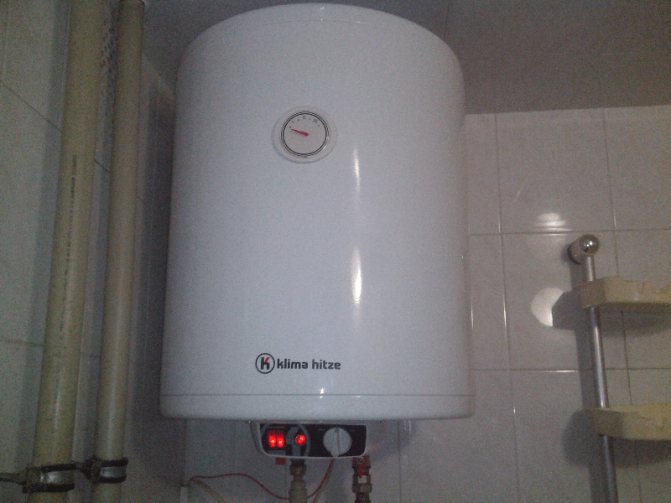

The question of how to save energy on the boiler worries many. It is no secret that any heating device - even a small kettle - consumes a lot of resources, the tariffs for which are very high.What can we say about equipment that is designed for 50, 80 or 100 liters of water. It is clear that a lot of electricity is required to heat such a volume.
Classification of water heating tanks
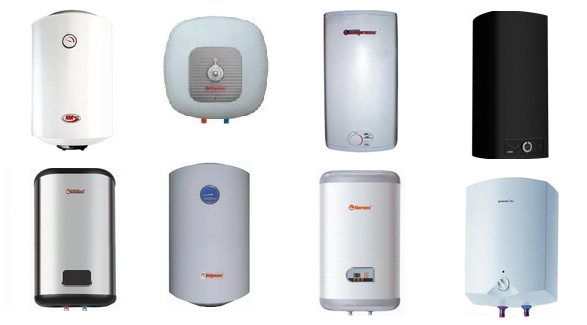

Varieties of wall-mounted water heating tanks
Water heating equipment is divided according to several criteria. Depending on the heating method:
- Accumulative. Such devices immediately heat a large amount of water in the tank, from where it is consumed for household needs, mixing with cold water.
- Flowing. These are special devices with a heating element, connected to the cold water supply network, heating the flowing water, depending on the power of the device, the volume and speed of the outflowing liquid.
Depending on the energy source:
- Electrical. Connected to a single-phase or three-phase network.
- Gas. Using the heat of the combustible mixture for work - propane, butane or other gases.


In the country, in order to save money, you can install a wood-fired boiler for water
A heating tank for storing water needs corrosion protection, so not all of them are made of iron. Types of tanks:
- made of high pressure plastic;
- enameled;
- glass-ceramic;
- titanium or stainless.
Plastic - the most budgetary. However, they are short-lived and are subject to deformation upon contact with a high-temperature environment.
The main disadvantage of enameled products is microcracks. They form when heated strongly. Therefore, it is advised to set the temperature to 60 degrees.
Titanium and stainless steel heating tanks are the most expensive and durable, they are not afraid of corrosion and deformation. They are installed in the equipment of leading companies.
Electrical


Wall mounted boiler with electric heating element
Electrical devices are convenient and safe to use.
Flowing electric water heaters are compact. They don't need to mix hot and cold water. They only heat it up to an acceptable temperature. The water heats up instantly. Heater power is high. Boilers with a capacity of 3.5 kW heat 3 liters. water to a temperature of 40 degrees. Instantaneous water heating boilers are good for use in places with interruptions in centralized hot water supply. Perfect for a single water draw-off point. If there are more water points, the heating may not be enough. Advantages of flow heaters:
- compactness;
- instant warm-up;
- use only when necessary, when idle it does not turn on;
- a sudden interruption of DHW is excluded.
Minuses:
- high power is not suitable for all wiring;
- large electricity bills;
- overheating of water in the absence of a heating limiter.
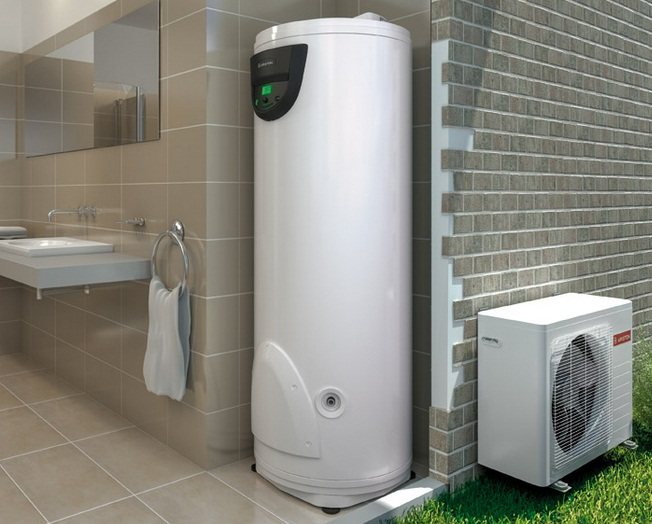

Large devices should preferably be placed on the floor
Flow-through products can be free-flow and pressure-free. The latter distribute the flow of water to several points of analysis.
The storage boiler for the apartment is equipped with a 10-200 liter tank. Outgoing water is mixed with cold water in the mixer and is supplied to the outlet while it is already warm. When the water flows or cools down, the boiler turns on again. On average, 40-50 liters of water is spent on washing a person. A family of 3 people needs 50-80 liters to take a shower. To take a bath, heat is required to the maximum.
Electric water heating tanks over 150 liters are placed on the floor in private houses. They consume a lot of electricity.
The main advantages of storage boilers for the home:
- profitability - average power 1.5-3 kW;
- one is enough for all the water points of the house;
- durability.
Gas
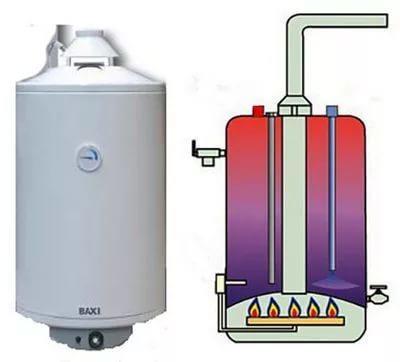

Wall-mounted gas boiler
Directly heated flow heaters heat the water passing through the coil. Gas is connected after the supply of water pressure.
Pros:
- compact design, easily fits under a sink or bath;
- high power;
- the cost of raw materials is low.
Minuses:
- connection exclusively by a trained specialist,
- fire hazard,
- replacement of cylinders when working with liquefied gas.
Accumulative models are similar in design to electrical ones. The energy source is a gas burner for operation on main or liquefied gas, does not require electricity.
Equipped with two types of combustion chambers - closed and open. In the second case, additional air extraction is required.
Advantages of gas storage domestic boilers:
- fuel economy;
- fast heating;
- work without electricity.
Minuses:
- cost of equipment;
- installation cost;
- relative fire hazard.
Liquefied gas models are often used in the country.
Indirect
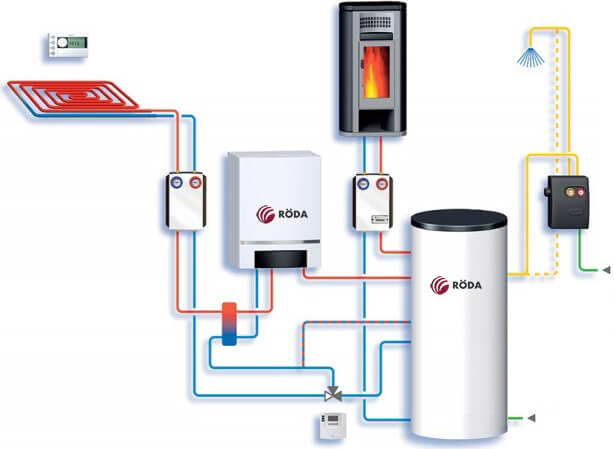

Installation diagram of an indirect heating boiler
This type of heater is used by owners of private houses. They need to supply DHW cheaply to the kitchen and to the bathrooms at the same time. The unit is expensive, but does not have its own heating system, it is connected to the central DHW system. It is recommended to be used in tandem with a single-circuit boiler. A plus is the ability to provide all the points of water intake with hot water at the same temperature. The downside is the cost, volume of the structure.
Combined
These devices combined flow and storage models. Small water heating tanks of 10-30 liters weigh only 6 kg. They work by choice in one of the modes. The number of models is limited. The price is high.
Reducing DHW costs
Choosing a location for installation
Selecting the operating mode of the equipment
Cleaning the heating element
In this regard, many are looking for a way to at least slightly reduce consumption so that the availability of hot water in the house does not cost a pretty penny. Fortunately, there are several simple methods for this, which absolutely do not contradict the legislation. To use them, you do not need any specific knowledge or skills to work with electrical engineering - everything is quite simple.
The first thing to do is to make the right choice of location to install your new acquisition. The second is to play a little with the operating modes of the equipment, choosing the most advantageous scheme. The third is to pay close attention to the condition of the heating element. But let's take a closer look at everything.
Choosing a location for installation
As you know, the boiler is connected to the draw-off points - that is, for example, with mixers - using pipes. When you are not using hot water for several hours, when you open the tap, a slightly warm liquid will first pour out, and only then will you get the right temperature. The explanation for this is very simple. The water that was heated by the boiler, but not released through the tap, remains in the section of the pipeline connecting them. During the period of inactivity, it cools down, and when the mixer is opened, it is drained.
Thus, you waste a certain amount of electricity that was wasted on heating this volume, wasted. The longer the pipe leading from the water heater to the nearest draw-off point, the more significant these losses will be. As an approximate figure, you can take 400 ml of water for each meter of the pipeline.
To avoid these, albeit not too large, losses, there is a simple way. Initially, install the boiler so that the pipe section between it and the nearest (or most frequently used) mixer is as short as possible. For example, if a water heater serves both the bathroom and the kitchen, then it is advisable to place it between them, and so that the water path to the second room is shorter - after all, the water is usually turned on there much more often.
Possibilities of energy saving when using an electric water heater
If a boiler is used to supply hot water, energy savings can be achieved in several ways:
- the heating temperature can be adjusted to reduce energy consumption without sacrificing user comfort;
- do not use the equipment when there is no need for hot water;
- use alternative energy sources, the cost of which is lower than the utility tariff;
- timely clean, removing scale and deposits inside the equipment.
Let's consider how to save energy on the boiler by setting the temperature regime. Most electric water heaters are capable of heating up to 75 ° C. However, such a hot temperature is not always necessary. Accordingly, if this indicator is reduced, the heating element will spend less time on heating, i.e. consume less electricity. The heat loss in standby mode depends on the water temperature. The higher the temperature, the higher the heat loss. A comfortable temperature for users is 50-55 ° C. Therefore, to reduce consumption, you can immediately install it on a water heater.
Very often, the owners of boilers have a situation when, after heating the water, it is not completely consumed. Cooling occurs naturally, which leads to unnecessary and unnecessary energy consumption. If you try to minimize these situations, you can provide additional savings.
A boiler, or an electric water heater, is a device for providing housing with hot water, which has become widespread due to its ease of use. The plus is that no installation permit is required, and the minus is that it consumes electricity. Energy savings are possible with the correct operation of the boiler and the observance of several rules that reduce energy consumption.
